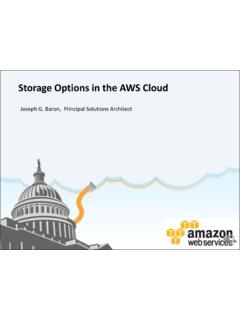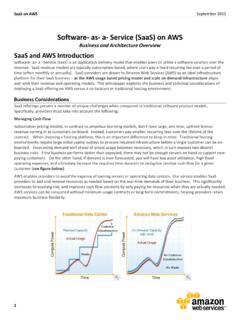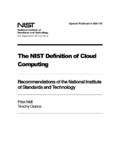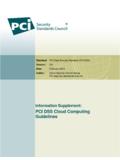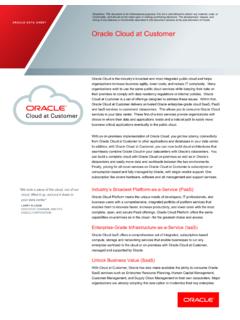Transcription of White Paper - d36cz9buwru1tt.cloudfront.net
1 White Paper Amazon Web Services: Enabling Cost-Efficient Disaster Recovery Leveraging cloud Infrastructure By Lauren Whitehouse and Jason Buffington January, 2012. This ESG White Paper was commissioned by Amazon Web Services LLC. and is distributed under license from ESG. 2012, Enterprise Strategy Group, Inc. All Rights Reserved White Paper : Amazon Web Services: Enabling Cost-Efficient Disaster Recovery Leveraging cloud Infrastructure 2. Contents The cloud is Ideal for Disaster Recovery .. 3. Risks are Abundant .. 3. Challenges to Implementing DR .. 4. Hot, Warm, or Cold Standby - Which to Choose? .. 4. DR Testing Can Be Problematic .. 6. Virtualization and cloud Infrastructure Services Enable DR.
2 6. Is the cloud for Everyone? .. 8. Amazon Web Services .. 9. Durability Amazon Web Services Regions and Availability Zones .. 10. Amazon S3 .. 10. Amazon 10. Amazon EBS .. 10. No-Fee Data Import .. 10. AWS Direct Connect .. 11. Amazon Virtual Private cloud .. 11. AWS Import/Export .. 11. AWS Storage Gateway .. 11. Security and Compliance .. 12. Leveraging AWS Components for DR .. 13. The Bigger Truth .. 14. All trademark names are property of their respective companies. Information contained in this publication has been obtained by sources The Enterprise Strategy Group (ESG) considers to be reliable but is not warranted by ESG. This publication may contain opinions of ESG, which are subject to change from time to time.
3 This publication is copyrighted by The Enterprise Strategy Group, Inc. Any reproduction or redistribution of this publication, in whole or in part, whether in hard-copy format, electronically, or otherwise to persons not authorized to receive it, without the express consent of the Enterprise Strategy Group, Inc., is in violation of copyright law and will be subject to an action for civil damages and, if applicable, criminal prosecution. Should you have any questions, please contact ESG Client Relations at (508) 482-0188. 2012, Enterprise Strategy Group, Inc. All Rights Reserved. White Paper : Amazon Web Services: Enabling Cost-Efficient Disaster Recovery Leveraging cloud Infrastructure 3.
4 The cloud is Ideal for Disaster Recovery cloud infrastructure is gaining in popularity for organizations that have very real business needs that rely on information technology (IT) infrastructure but struggle with the costs both capital and operational of expanding their data centers. But before even discussing the cloud , it's worthwhile to settle on a definition. ESG defines a cloud infrastructure as follows: A computing model in which the equipment including servers, storage, and networking components used to support an organization's IT operations is hosted by a service provider and made available to customers over a network, typically the Internet. The service provider owns the equipment and is responsible for housing, running, and maintaining it, with the client typically paying on a per-use basis.
5 Today, more than three-quarters (82%) of organizations have plans to leverage cloud -based services to some extent over the next five The cost, agility, and flexibility benefits are too obvious to deny, particularly for tasks such as disaster recovery (DR)2. DR is an ideal use case for taking advantage of the cloud . While many organizations remain cautious about placing production services in the cloud , they are often more comfortable testing those waters for DR especially since the cloud alters the economics of DR so radically. Some organizations implement DR only for their most critical applications to minimize risk and keep expenses in check. Using the cloud enables companies to extend DR services to additional workloads, further reducing their exposure to business interruption.
6 Others that currently operate failover sites are finding the costs skyrocketing because of continual data growth. But for many (particularly smaller) organizations, the cloud actually makes DR possible for the first time. This Paper outlines the problems organizations face when implementing DR, describes how the cloud changes the game, and provides some insight into a suite of components from Amazon Web Services (AWS) that make DR in the cloud simple and cost-efficient. Risks are Abundant Why is DR so important? Every organization is vulnerable to a range of outages and disasters. Computer viruses are everywhere; applications and disk drives are vulnerable to faults; data can become corrupted; and of course, human error is an ever-present threat.
7 While none of these seem like disasters, the interruptions they cause can wreak havoc on daily business activities. Given that, imagine the impact of real disasters such as fires, floods, power failures, or weather-related outages. Whether caused by technical problems or natural phenomena, this unplanned downtime must be immediately addressed by IT organizations in order to restore business to a fully operational state. The absence of a DR strategy and plan comes with significant risk. Business downtime can result in huge losses in productivity. Breaches of customer service agreements, whether explicit or implied, can cause irreparable damage to reputations and/or financial assets.
8 In ESG research on data protection, 74% of survey respondents state they could withstand three hours or less of downtime for tier-1 (business-critical) data before experiencing adverse business affects, and more than half (53%) could only tolerate one hour or less of tier-1 downtime3. Aggressive recovery objectives are common in today's business environment where global operations and 24/7. productivity are typical. IT must deliver on contracted recovery time objectives (RTOs, defined as the amount of time between an outage and operational resumption) and recovery point objectives (RPOs, defined as the amount of data loss that the organizations can tolerate in the transition).
9 Once the implications of downtime and data loss 1. Source: ESG Research Report, cloud Computing Adoption Trends, May 2011. 2. DR is defined as the act or process of invoking pre-planned procedures after a pre-determined period of time has elapsed in order to recover critical business system functions, application servers, and applications from loss, which may include retrieving data from backup copies or replication targets as a result of a catastrophe.. 3. Source: ESG Research Report, Data Protection Trends, April 2010. 2012, Enterprise Strategy Group, Inc. All Rights Reserved. White Paper : Amazon Web Services: Enabling Cost-Efficient Disaster Recovery Leveraging cloud Infrastructure 4.
10 Are understood, IT organizations can determine application availability requirements and the proper protection mechanisms to apply to ensure compliance. To meet service level agreements (SLAs), organizations often utilize various layers of data protection using a mix of replication/mirroring technologies for primary system and storage IT. continuity. Snapshots and daily backups are commonly used for operational recovery and DR. However, the result is over insurance for top tier applications and data (resulting in extra up-front expenses that may not be needed), and under insurance for lower tiers (resulting in extra expenses after a disaster). Challenges to Implementing DR.
